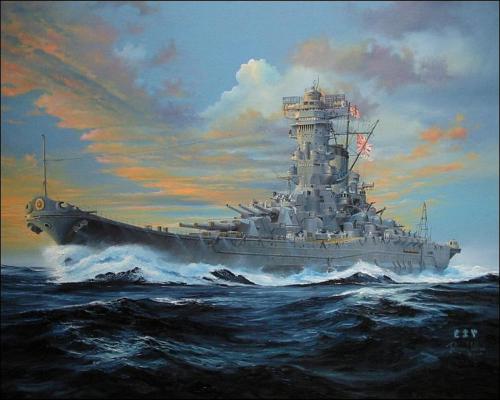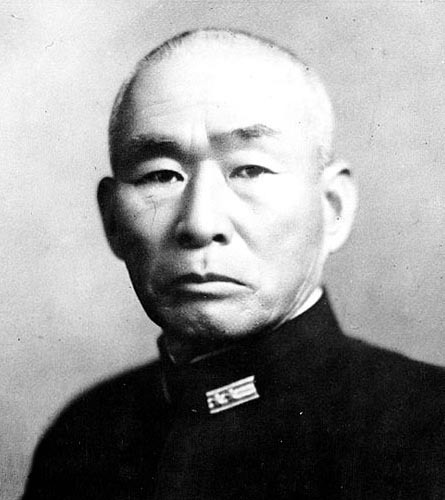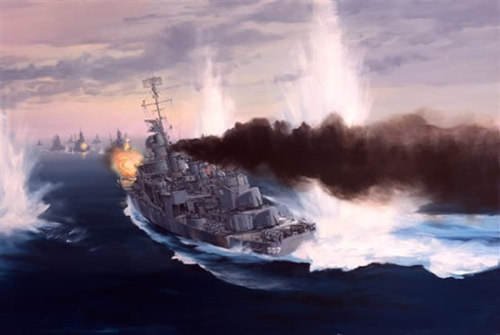Taffy 3 vs. Goliath,On October 20th, 1944 200,000 US troops under the command of General Douglas Mac
Taffy 3 vs. Goliath,On October 20th, 1944 200,000 US troops under the command of General Douglas MacArthur landed on the Island of Leyte with the goal of capturing the Philippines. For the Japanese, the loss of the Philippines could sound the end of the empire as the Americans could cut of Japanese access to its oil fields in Indonesia. The remnants of the Japanese navy had few aircraft carriers, and depended heavily on their large, powerful battleships.To defend the Philippines, Japanese Admiral Takeo Kurita (pictured above right) had a plan to put Japan’s battleships to use. Kurita planned to use Japans remaining carrier fleet as a diversion. As the carrier fleet steamed away from the Philippines it was hoped that the American 3rd Fleet under Admiral William Halsey would take chase, allowing a hidden fleet of battleships to sweep in and bombard the American landing forces at Leyte. Halsey took Kurita’s bait hook line and sinker, steaming away from Leyte and leaving the remaining forces vulnerable. What was left was Taffy 3, a support squadron of 6 small escort carriers with 400 aircraft, 3 destroyers, and 3 destroyer escorts. The ships of Taffy 3 were their to provide naval and air support for the landing forces, as well as root out Japanese submarines. It was not meant for full scale naval combat against a Japanese war fleet. On October 25th, 1944 Kurita’s force of battleships appeared over the horizon, intent on destroying Taffy 3 and annihilating the landing force. Admiral Kirita’s force consisted of 4 battleships, 6 heavy cruisers, 2 light cruisers, and 11 destroyers. At the head of the fleet was the Japanese battleship IJS Yamato, the largest battleship in history. Armed with nine 18 inch guns and with a displacement of 71,659 tons, the Yamato was larger than all the ships of Taffy 3 combined. The destroyers and destroyer escorts were armed with 5 inch guns, which were mere spitwad shooters against the armor of a Japanese battleship. They were, however, armed with torpedoes, which could certainly do some terrible damage to the Japanese fleet.As soon as the Japanese fleet was within range they opened fire on Taffy 3. The embattled ships formed a defensive formation with the destroyers forming a protective circle around the escort carriers. The destroyers also laid down a smokescreen to make it harder for the Japanese to attack the fleet. Regardless, it was clear that the Japanese battleships could easily obliterate Taffy 3. The captain of the destroyer USS Johnson, Lt. Commander Ernest E. Evans (pictured above, left) knew that it was only a matter of time before the Japanese blew Taffy three out of the water. Sometimes in desperate situations, the only thing to do is fix bayonets and charge. Evans ordered the Johnston to break formation and attack the Japanese head on. Steaming in a zig zag pattern the Johnston avoided the fire of the Japanese heavy guns. When in gun range itself, the Johnston opened up with her five inch guns, targeting soft points on the Japanese ships such as the bridge and smaller gun turrets. When within torpedo range, the Johnston fired her spread of torpedoes. One of the torpedoes struck the heavy cruiser Kuomo, ripping off the ships entire bow and forcing it to retreat.After the torpedo attack the Johnston continued firing her 5 inch guns, but soon she became the target of every ship in the Japanese fleet. After a hard pounding in which she was struck several times with heavy shells, the Johnston was forced to limp away from the action. The Johnston’s captain, Ernest Evans, was also badly wounded but remained in command. Inspired by the attack, Taffy 3’s commander, Admiral Clifton Sprague, ordered the rest of the destroyers and destroyer escorts to attack. The destroyers made their torpedo runs, which successfully sunk and damaged many ships, then engaged the battleships muzzle to muzzle with their puny 5 inch guns. In the meantime, hundreds of Taffy 3’s aircraft were scrambled. Meant for close ground support of the landing force, they were armed with light bombs, rockets, and machine guns, not the heavy armor piercing bombs needed to sink a Japanese battleship. Nevertheless the the fighters and bombers of Taffy 3 attacked, dropping bombs on the battleships bridges and strafing them with machine guns and rockets. When they ran out of ammo, the pilots continued the attack by making dry runs to distract the battleships. There are even reports of pilots firing at battleship decks with their pistols.The last assault of the Japanese fleet was a torpedo run on Taffy 3’s escort carriers by the fleet’s 11 destroyers escorted by a light cruiser. With the other American destroyers occupied, there was nothing to stop them except for the battered USS Johnston. The Johnston opened fire once again with her 5-inch guns. Though a pitiful defense, it was enough to scare the destroyers into launching their torpedoes too early. Not one Japanese torpedo hit its mark. The Johnston paid the price, however, as the Japanese destroyers surrounded it, and pounded the ship until it was nothing more than a sinking hulk. 187 of the Johnston’s 327 men went down with her, among them Captain Ernest Evans, who remained at his post to the last.After the devastating torpedo attack, the failed Japanese torpedo attack, and the continuing harassment by American aircraft, Admiral Kirita ordered the fleet to retreat. The ferocious attack against the Japanese fleet convinced Korita that he was up against an entire fleet formation rather than a small destroyer squadron. While plucky little Taffy 3 was the winner of the battle, it lost 2 destroyers, 2 escort carriers, and 1 escort destroyer. The Japanese fleet, however, had suffered a horrific bloody nose. 3 Japanese heavy cruisers were sunk, 3 heavy cruisers were damaged, 2 light cruisers were damaged, and 1 destroyer was damaged. Taffy 3 had indeed beaten Goliath. After the battle Taffy 3 was awarded a Presidential Unit Citation while Captain Ernest Evans was posthumously awarded the Medal of Honor. -- source link
Tumblr Blog : peashooter85.tumblr.com
#history#navy#us navy#wwii#pacific#naval warfare#taffy 3#battle#war#battleships#destroyers#battleship yamato



